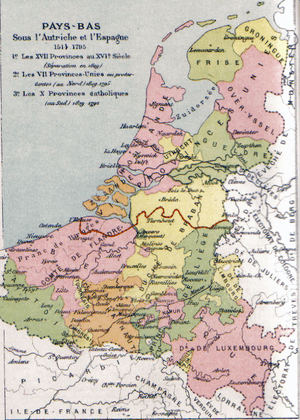Southern Netherlands facts for kids
The Southern Netherlands was a historical region in Europe. It was part of the Low Countries, which today includes most of Belgium and Luxembourg. This area was controlled by different powerful countries for many years.
First, Spain ruled the Southern Netherlands from 1556 to 1714. Then, Austria took control from 1714 to 1794. Finally, it became part of France from 1794 to 1815.

The Southern Netherlands included most of modern-day Belgium and Luxembourg. It also covered the Imperial Abbey of Stavelot-Malmedy and the County of Bouillon. Some parts of the modern Netherlands were also included. Until 1678, much of what is now the Nord-Pas-de-Calais region in northern France was part of it too. This region was part of the Holy Roman Empire before France took it over.
How the Netherlands Split
The northern seven provinces of the Low Countries decided to become independent. They were led by areas like Holland and Zeeland. These provinces formed the Dutch Republic, also known as the United Provinces, after 1581.
Meanwhile, the southern parts were brought back under Spanish control. This was done by a Spanish general named Alexander Farnese, Duke of Parma.
Changing Rulers and New Countries
After the War of the Spanish Succession in the early 1700s, the Southern Netherlands changed hands again. They became part of the Austrian Habsburg lands.
Later, after the French Revolutionary Wars, the Southern Netherlands were joined with the northern Netherlands. This happened at the 1815 Congress of Vienna. They became a single kingdom under the House of Orange-Nassau.
In 1830, the southern half of this new kingdom became independent. This area was mostly Roman Catholic. It formed the new country we know today as the Kingdom of Belgium. The south-eastern part of Luxembourg Province also became the country of Luxembourg.
Images for kids
-
A map showing the lands controlled by the Habsburg family in 1547. Their lands in the Low Countries were kept by the Spanish Habsburgs from 1556.
-
A silver coin from Emperor Charles V around 1553. It shows the coat of arms for the Low Countries.
See also
 In Spanish: Países Bajos meridionales para niños
In Spanish: Países Bajos meridionales para niños





